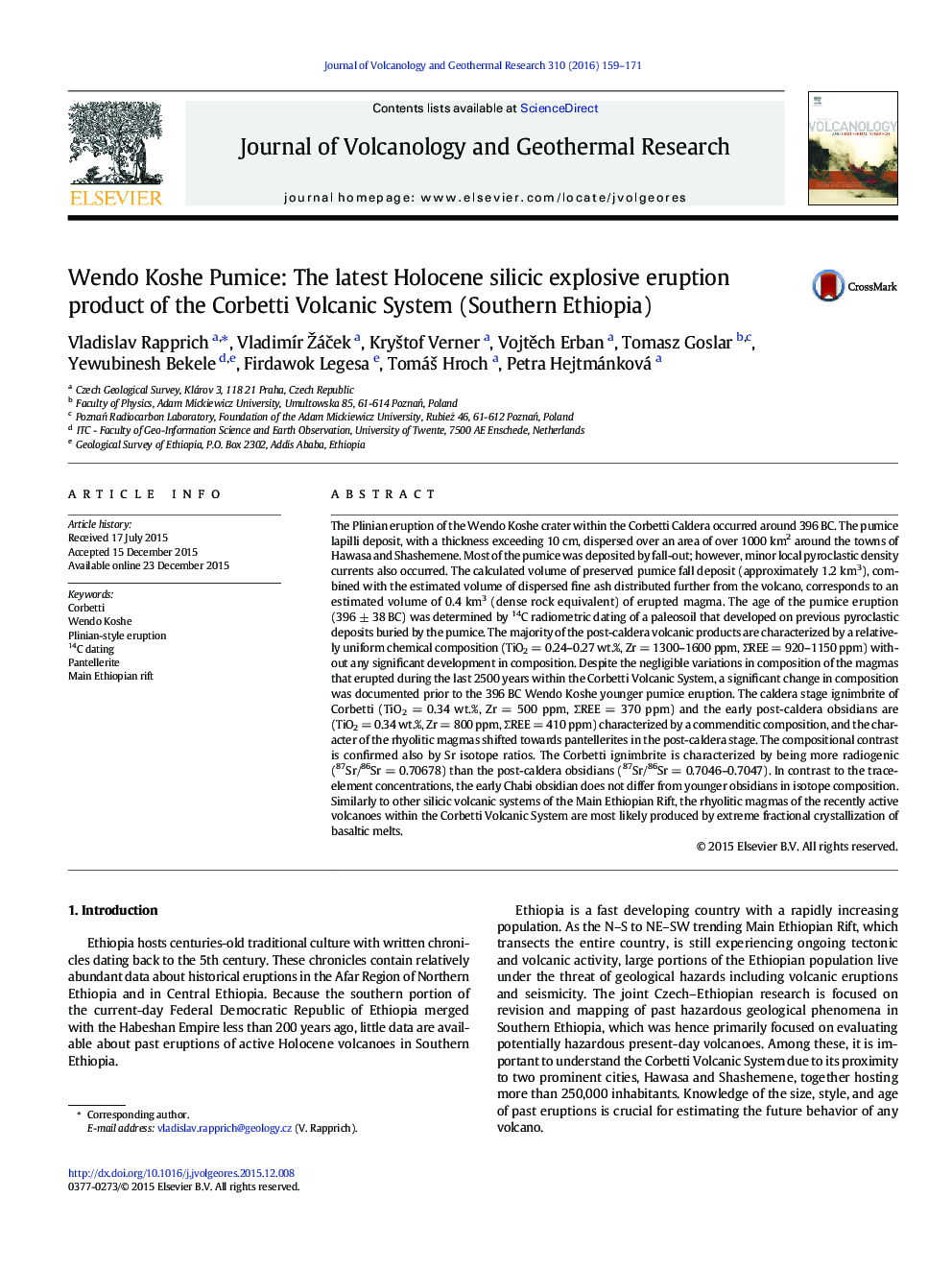| کد مقاله | کد نشریه | سال انتشار | مقاله انگلیسی | نسخه تمام متن |
|---|---|---|---|---|
| 6439981 | 1638312 | 2016 | 13 صفحه PDF | دانلود رایگان |
عنوان انگلیسی مقاله ISI
Wendo Koshe Pumice: The latest Holocene silicic explosive eruption product of the Corbetti Volcanic System (Southern Ethiopia)
دانلود مقاله + سفارش ترجمه
دانلود مقاله ISI انگلیسی
رایگان برای ایرانیان
موضوعات مرتبط
مهندسی و علوم پایه
علوم زمین و سیارات
ژئوشیمی و پترولوژی
پیش نمایش صفحه اول مقاله

چکیده انگلیسی
The Plinian eruption of the Wendo Koshe crater within the Corbetti Caldera occurred around 396 BC. The pumice lapilli deposit, with a thickness exceeding 10 cm, dispersed over an area of over 1000 km2 around the towns of Hawasa and Shashemene. Most of the pumice was deposited by fall-out; however, minor local pyroclastic density currents also occurred. The calculated volume of preserved pumice fall deposit (approximately 1.2 km3), combined with the estimated volume of dispersed fine ash distributed further from the volcano, corresponds to an estimated volume of 0.4 km3 (dense rock equivalent) of erupted magma. The age of the pumice eruption (396 ± 38 BC) was determined by 14C radiometric dating of a paleosoil that developed on previous pyroclastic deposits buried by the pumice. The majority of the post-caldera volcanic products are characterized by a relatively uniform chemical composition (TiO2 = 0.24-0.27 wt.%, Zr = 1300-1600 ppm, ƩREE = 920-1150 ppm) without any significant development in composition. Despite the negligible variations in composition of the magmas that erupted during the last 2500 years within the Corbetti Volcanic System, a significant change in composition was documented prior to the 396 BC Wendo Koshe younger pumice eruption. The caldera stage ignimbrite of Corbetti (TiO2 = 0.34 wt.%, Zr = 500 ppm, ƩREE = 370 ppm) and the early post-caldera obsidians are (TiO2 = 0.34 wt.%, Zr = 800 ppm, ƩREE = 410 ppm) characterized by a commenditic composition, and the character of the rhyolitic magmas shifted towards pantellerites in the post-caldera stage. The compositional contrast is confirmed also by Sr isotope ratios. The Corbetti ignimbrite is characterized by being more radiogenic (87Sr/86Sr = 0.70678) than the post-caldera obsidians (87Sr/86Sr = 0.7046-0.7047). In contrast to the trace-element concentrations, the early Chabi obsidian does not differ from younger obsidians in isotope composition. Similarly to other silicic volcanic systems of the Main Ethiopian Rift, the rhyolitic magmas of the recently active volcanoes within the Corbetti Volcanic System are most likely produced by extreme fractional crystallization of basaltic melts.
ناشر
Database: Elsevier - ScienceDirect (ساینس دایرکت)
Journal: Journal of Volcanology and Geothermal Research - Volume 310, 15 January 2016, Pages 159-171
Journal: Journal of Volcanology and Geothermal Research - Volume 310, 15 January 2016, Pages 159-171
نویسندگان
Vladislav Rapprich, VladimÃr ŽáÄek, KryÅ¡tof Verner, VojtÄch Erban, Tomasz Goslar, Yewubinesh Bekele, Firdawok Legesa, TomáÅ¡ Hroch, Petra Hejtmánková,